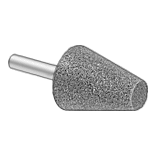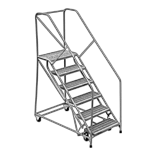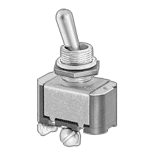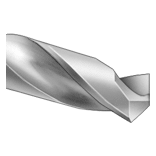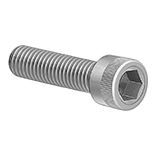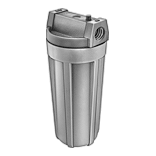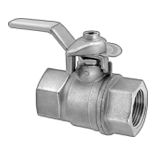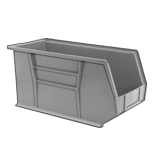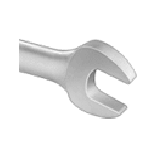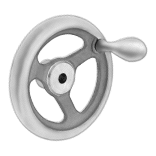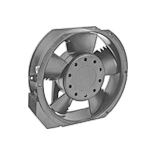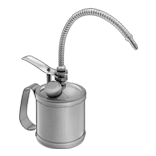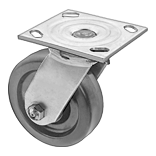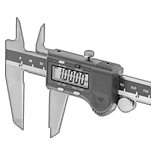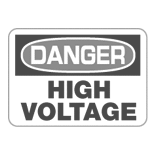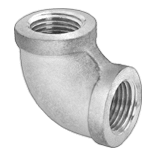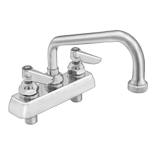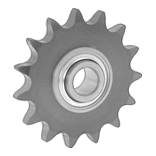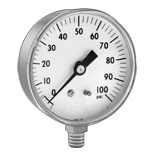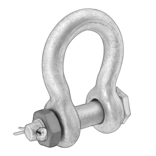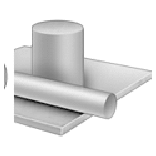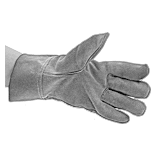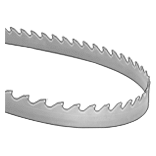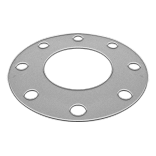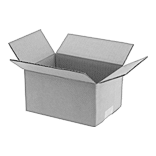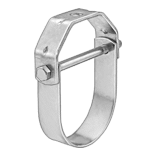Wear-Resistant Nylon 3D Printer Filaments
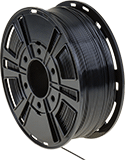 | Black |
Off-White |
Print tough, long-lasting parts that won’t scratch or wear out from constant motion and friction, such as gears and washers. You can even tap or drill the parts without them cracking or shattering.
Use these filaments with fused filament fabrication (FFF) printers. Because of their relatively high melting point, a heated printer bed is recommended. These filaments also emit fumes when printing, so it’s best to use them in an enclosed printer or to remove the fumes with a fume exhauster. Store them in a sealed container with a desiccant so they don’t absorb moisture in the air, which can make them unusable.
Nylon 6/69 filaments stand up to chemicals for use in a variety of chemical processing applications. They’re also FDA Compliant 21 CFR 177.1395 and FDA Compliant 21 CFR 177.1500, so they can be used to produce parts that are intended for processing, handling, and packaging food and beverages.
Tensile strength is the best measure of a filament's overall strength. Similar to the stress applied on a rope during a game of tug-of-war, it's the amount of pulling force a material can handle before breaking. A higher rating means a stronger filament. A tensile strength of 5,000 psi and above is considered good; 12,000 psi and above is excellent.
Maximum exposure temperature is the point at which a printed part will begin to deform. Above this temperature, your printed parts will start to lose structural integrity.
Spool | ||||||||||||
|---|---|---|---|---|---|---|---|---|---|---|---|---|
| Dia., mm | Printing Temp. | For Printer Bed Temp. | Tensile Strength | Hardness | Max. Exposure Temp. | Specifications Met | For Min. Nozzle Opening Dia., mm | Dia., mm | Dp., mm | Wt., g | Each | |
Nylon Plastic 6/69 | ||||||||||||
Black | ||||||||||||
| 2.85 | 250° to 255° C 482° to 491° F | 30° to 65° C 86° to 149° F | 8,100 psi (Good) | Not Rated | 82° C 180° F | FDA Compliant 21 CFR 177.1395, FDA Compliant 21 CFR 177.1500 | 0.2 | 200 | 70 | 1,000 | 0000000 | 000000 |
Off-White | ||||||||||||
| 2.85 | 250° to 255° C 482° to 491° F | 30° to 65° C 86° to 149° F | 8,100 psi (Good) | Not Rated | 82° C 180° F | FDA Compliant 21 CFR 177.1395, FDA Compliant 21 CFR 177.1500 | 0.2 | 200 | 70 | 1,000 | 0000000 | 00000 |
Slippery Wear-Resistant 3D Printer Filaments

Often used to make bearings, worm gears, and other smooth moving parts, these filaments create parts that won’t wear out from constant motion. They're a slippery thermoplastic blend, so they have better wear resistance and lower friction than other filaments.
Print these filaments on a fused filament fabrication (FFF) printer. Because of their high melting point, a heated printer bed is recommended since the parts will cool too quickly and warp without it. You must use an enclosed printer or fume exhauster while printing these filaments. Store them in a sealed container with a desiccant, or use a dehumidifying cabinet, since moisture in the air can degrade their printing quality.
Maximum exposure temperature is the point at which a printed part will begin to deform. Above this temperature, your printed parts will start to lose structural integrity.
Spool | |||||||||||
|---|---|---|---|---|---|---|---|---|---|---|---|
| Dia., mm | Printing Temp. | For Printer Bed Temp. | Tensile Strength | Hardness | Max. Exposure Temp. | For Min. Nozzle Opening Dia., mm | Dia., mm | Dp., mm | Wt., g | Each | |
Thermoplastic Blend | |||||||||||
Beige | |||||||||||
| 1.75 | 260° to 280° C 500° to 536° F | 100° to 130° C 212° to 266° F | Not Rated | Durometer 66D (Medium) | 120° C 248° F | 0.4 | 205 | 70 | 750 | 000000 | 0000000 |
| 2.85 | 260° to 280° C 500° to 536° F | 100° to 130° C 212° to 266° F | Not Rated | Durometer 66D (Medium) | 120° C 248° F | 0.4 | 205 | 70 | 750 | 0000000 | 000000 |
Flexible TPU 3D Printer Filaments
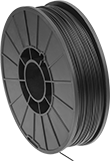 | ||||
Stretchy, soft, and sturdy, these filaments make durable parts that resist breakage despite repeated use. Stronger than ABS and PLA filaments, they create long-lasting parts, such as seals, sleeves, and gaskets, as well as components that take on high-impact forces, such as springs and snap-fit parts. These filaments don't require a heated printer bed, and they won't shrink or warp when cooling. Use them with a fused filament fabrication (FFF) 3D printer. In general, these flexible filaments require a slow feed rate so they don't jam. The softer your filament, the slower your feed rate will need to be. Store them in a sealed container with a desiccant, or use a dehumidifying cabinet, since ambient humidity will cause the plastic to degrade and weaken.
Conductive filaments can be used to create circuit prototypes and other conductive pathways. You can adjust the surface resistivity by changing the temperature of your printer's extruder. As the extruder’s temperature increases, the printed part’s resistivity will decrease.
For the most flexible parts, use durometer 85A filaments. They're more flexible than other TPU filaments. For a quick print without sacrificing flexibility, choose durometer 95A filaments. They print much faster than other TPU filaments.
Tensile strength is the best measure of a filament's overall strength. Similar to the stress applied on a rope during a game of tug-of-war, it's the amount of pulling force a material can handle before breaking. A higher rating means a stronger filament. A tensile strength of 5,000 psi and above is considered good; 12,000 psi and above is excellent.
Maximum exposure temperature is the point at which a printed part will begin to deform. Above this temperature, your printed parts will start to lose structural integrity.
Spool | ||||||||||||
|---|---|---|---|---|---|---|---|---|---|---|---|---|
| Dia., mm | Printing Temp. | For Printer Bed Temp. | Tensile Strength | Surface Resistivity | Max. Exposure Temp. | For Min. Nozzle Opening Dia., mm | Dia., mm | Dp., mm | Wt., g | Choose a Color | Each | |
TPU Plastic—Durometer 85A (Medium Soft) | ||||||||||||
| 1.75 | 225° to 235° C 437° to 455° F | 21° to 40° C 70° to 104° F | 580 psi | __ | 44° C 111° F | 0.25 | 200 | 70 | 1,000 | 00000000 | 000000 | |
| 2.85 | 225° to 235° C 437° to 455° F | 21° to 40° C 70° to 104° F | 580 psi | __ | 44° C 111° F | 0.25 | 200 | 70 | 1,000 | 00000000 | 00000 | |
TPU Plastic—Durometer 95A (Medium Soft) | ||||||||||||
| 1.75 | 230° to 240° C 446° to 464° F | 21° to 40° C 70° to 104° F | 1,250 psi | __ | 49° C 120° F | 0.25 | 200 | 70 | 1,000 | 00000000 | 00000 | |
| 2.85 | 230° to 240° C 446° to 464° F | 21° to 40° C 70° to 104° F | 1,250 psi | __ | 49° C 120° F | 0.25 | 200 | 70 | 1,000 | 00000000 | 00000 | |
Conductive TPU Plastic—Durometer 90A (Medium Soft) | ||||||||||||
| 1.75 | 220° to 230° C 428° to 446° F | 45° C 113° F | 1,700 psi | 1.5 × 103 ohms-cm | Not Rated | 0.4 | 200 | 50 | 1,000 | Opaque Black | 0000000 | 000000 |
| 2.85 | 220° to 230° C 428° to 446° F | 45° C 113° F | 1,700 psi | 1.5 × 103 ohms-cm | Not Rated | 0.4 | 200 | 50 | 1,000 | Opaque Black | 0000000 | 000000 |
Moisture-Resistant Polyester 3D Printer Filaments
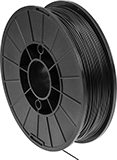 | |
Parts printed with these polyester filaments absorb less moisture than other types of plastic, making them ideal for use in wet or humid environments. They are more durable and flexible than PLA, and easier to print than ABS. Use these filaments with fused filament fabrication (FFF) 3D printers, and print onto a heated print bed. Printing onto a cool surface causes the molten filament to change temperature rapidly, which can warp your designs. Although finished parts are moisture-resistant, these filaments are sensitive to humidity, and should be stored in a dehumidifying cabinet or a sealed container with desiccant for the best printing quality.
PETT forms strong bonds between layers, so prints will not split apart. It is often used to make large models with large layers.
PETG contains glycol, so it is less brittle and easier to print than PETT and PCTG. Carbon-fiber-filled PETG is often used to make rigid parts that are difficult to bend and break. Finished parts are easier to thread and machine than unfilled parts. Because these filaments are abrasive, use them only with abrasion-resistant nozzles.
Antistatic filaments make parts that prevent the buildup of static electricity. This helps prevent the buildup of dust or fibers on the surface of your finished part. However, they are not as effective at preventing electrostatic discharge as static-dissipative filaments.
Tensile strength is the best measure of a filament's overall strength. Similar to the stress applied on a rope during a game of tug-of-war, it's the amount of pulling force a material can handle before breaking. A higher rating means a stronger filament. A tensile strength of 5,000 psi and above is considered good; 12,000 psi and above is excellent.
Maximum exposure temperature is the point at which a printed part will begin to deform. Above this temperature, your printed parts will start to lose structural integrity.
Spool | |||||||||||||
|---|---|---|---|---|---|---|---|---|---|---|---|---|---|
| Dia., mm | Printing Temp. | For Printer Bed Temp. | Tensile Strength | Hardness | Surface Resistivity, ohms/sq. | Max. Exposure Temp. | Specifications Met | For Min. Nozzle Opening Dia., mm | Dia., mm | Dp., mm | Wt., g | Each | |
PETT Plastic | |||||||||||||
Clear | |||||||||||||
| 2.85 | 235° to 242° C 455° to 468° F | 68° C 155° F | 4,060 psi (Poor) | Not Rated | __ | 76° C 169° F | FDA Compliant 21 CFR 177.1315 | 0.2 | 200 | 70 | 1,000 | 0000000 | 000000 |
Carbon-Fiber-Filled PETG Plastic—Antistatic | |||||||||||||
Opaque Black | |||||||||||||
| 1.75 | 230° to 260° C 446° to 500° F | 60° C 140° F | 8,120 psi (Good) | Not Rated | 109-1012 | 77° C 170° F | __ | 0.4 | 200 | 60 | 750 | 000000 | 00000 |
| 2.85 | 230° to 260° C 446° to 500° F | 60° C 140° F | 8,120 psi (Good) | Not Rated | 109-1012 | 77° C 170° F | __ | 0.4 | 200 | 60 | 750 | 0000000 | 00000 |
3D Printer Filaments for Casting
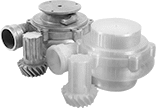
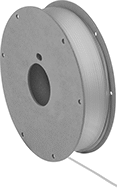
Create molds around parts printed with these filaments. They’re PVB, so they vaporize cleanly from your mold, similar to wax in traditional investment casting and lost wax casting. For a smoother surface on your mold, before casting you can apply isopropyl alcohol to remove the layer lines from your printed parts. Apply using a brush, sprayer, or vapor bath.
Tensile strength is the best measure of a filament’s overall strength. Similar to the stress applied on a rope during a game of tug-of-war, it’s the amount of pulling force a material can handle before breaking. A higher rating means a stronger filament. A tensile strength of 5,000 psi and above is considered good; 12,000 psi and above is excellent.
Maximum exposure temperature is the point at which a printed part will begin to deform. Above this temperature, your part will start to lose structural integrity.
Spool | ||||||||||
|---|---|---|---|---|---|---|---|---|---|---|
| Dia., mm | Printing Temp. | For Printer Bed Temp. | Tensile Strength | Max. Exposure Temp. | For Min. Nozzle Opening Dia., mm | Dia., mm | Dp., mm | Wt., g | Each | |
PVB Plastic | ||||||||||
Opaque Off-White | ||||||||||
| 1.75 | 190° to 220° C 374° to 428° F | 25° to 70° C 77° to 158° F | 4,930 psi (Poor) | 52° C 125° F | 0.4 | 200 | 50 | 750 | 0000000 | 000000 |
| 2.85 | 190° to 220° C 374° to 428° F | 25° to 70° C 77° to 158° F | 4,930 psi (Poor) | 52° C 125° F | 0.4 | 200 | 50 | 750 | 0000000 | 00000 |
Foam-Forming 3D Printer Filaments
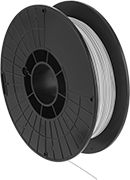
Print these polypropylene filaments into filters, gaskets, and other lightweight, foam-like parts that let air and gas pass through but repel water. They contain a filler that dissolves in water, forming hollow spaces that make up 45% of the part. Polypropylene is known for being rigid yet flexible, so it absorbs impacts and bounces back to shape after bending, making these filaments good for compressible seals and living hinges. It also resists hydrocholoric and phosphoric acids, as well as other nonoxidizing acids and bases.
These filaments work with fused filament fabrication (FFF) 3D printers. If using a glass print surface, apply an adhesive to prevent the filament from detaching. The recommended print speed is 25 mm/s. While polypropylene is likely to shrink, the filler in these filaments supports your design, preventing it from losing shape as it prints. Submerge your part in hot water for about 24 hours after printing to dissolve the filler and expose the pores.
For extra support when printing complex designs, use structural support 3D printer filaments. They dissolve in water at the same time as this filament’s filler.
Spool | |||||||||||||
|---|---|---|---|---|---|---|---|---|---|---|---|---|---|
| Dia., mm | Printing Temp. | For Printer Bed Temp. | Tensile Strength | Hardness | Max. Exposure Temp. | For Min. Nozzle Opening Dia., mm | Dia., mm | Dp., mm | Material | Wt., g | Color | Each | |
Polypropylene Plastic | |||||||||||||
| 1.75 | 190° to 240° C 374° to 464° F | 95° C to 125° C 203° F to 257° F | 1,000 psi (Poor) | Shore A90 (Medium Soft) | 140° C 284° F | 0.4 | 200 | 55 | Plastic | 500 | White | 0000000 | 0000000 |
| 2.85 | 190° to 240° C 374° to 464° F | 95° C to 125° C 203° F to 257° F | 1,000 psi (Poor) | Shore A90 (Medium Soft) | 140° C 284° F | 0.4 | 200 | 55 | Plastic | 500 | White | 0000000 | 000000 |
Foam-Forming Flexible 3D Printer Filaments
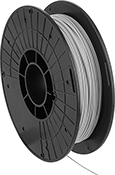
Create soft, stretchy parts that are lightweight and foam-like, letting air and gas pass through yet repelling water. These filaments are a TPE blend with a filler that dissolves in water, forming hollow spaces that make up to 45% of the part.
These filaments work with fused filament fabrication (FFF) 3D printers. If using a glass print surface, apply an adhesive to prevent the filament from detaching. The recommended print speed is 25 mm/s. Submerge your part in hot water for about 24 hours after printing to dissolve the filler and expose the pores.
For extra support when printing complex designs, use structural support 3D printer filaments. They dissolve in water at the same time as the filler in these filaments.
Tensile strength is the best measure of a filament’s overall strength. Similar to the stress applied on a rope during a game of tug-of-war, it’s the amount of pulling force a material can handle before breaking. A higher rating means a stronger filament. A tensile strength of 5,000 psi and above is considered good; 12,000 psi and above is excellent.
Maximum exposure temperature is the point at which a printed part will begin to deform. Above this temperature, your part will start to lose structural integrity.
Spool | |||||||||||||
|---|---|---|---|---|---|---|---|---|---|---|---|---|---|
| Dia., mm | Printing Temp. | For Printer Bed Temp. | Tensile Strength | Hardness | Max. Exposure Temp. | For Min. Nozzle Opening Dia., mm | Dia., mm | Dp., mm | Material | Wt., g | Color | Each | |
TPE Blend | |||||||||||||
| 1.75 | 220° to 250° C 428° to 482° F | 50° to 70° C 122° to 158° F | 150 psi | Durometer 91A (Medium Soft) | 49° C 120° F | 0.4 | 200 | 55 | Plastic | 500 | Beige | 0000000 | 000000 |
| 2.85 | 220° to 250° C 428° to 482° F | 50° to 70° C 122° to 158° F | 150 psi | Durometer 91A (Medium Soft) | 49° C 120° F | 0.4 | 200 | 55 | Plastic | 500 | Beige | 0000000 | 00000 |
